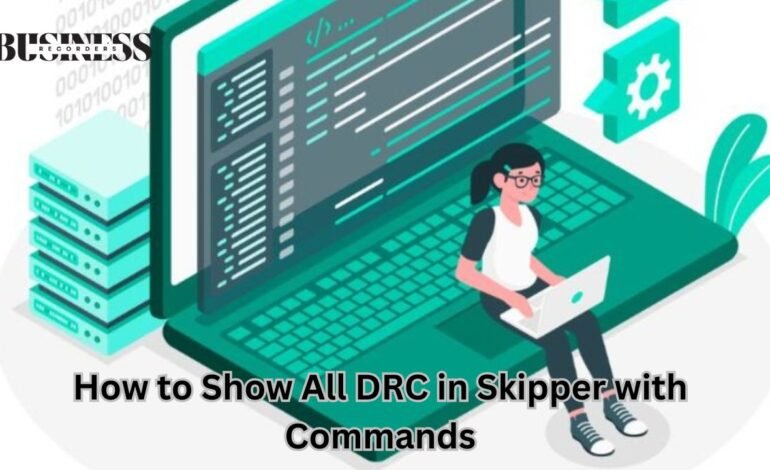
How to Show All DRC in Skipper with Commands
In the field of electronic design automation (EDA), ensuring that electronic components function as intended is crucial. One important aspect of this process is the Design Rule Check (DRC), which verifies that a design meets specified guidelines. Skipper is one of the popular tools used for performing these checks efficiently. This article will provide a comprehensive overview of how to show all DRC in Skipper with commands, ensuring that you can utilize this powerful tool effectively.
What is DRC and Why is It Important?
Design Rule Check (DRC) is a process that validates a layout against established design rules. These rules help maintain the integrity and functionality of a design by preventing potential issues that could arise during manufacturing. DRC is essential for several reasons:
- Error Detection: DRC identifies design errors before manufacturing, allowing designers to correct issues early in the process. This proactive approach saves time and money in the long run.
- Compliance: Many industries have strict design standards that must be met. DRC helps ensure that designs comply with these standards, which can vary based on the type of electronic device being produced.
- Reliability: By adhering to design rules, the reliability of the final product is increased. This reduces the likelihood of failures in the field, which can be costly and damaging to a company’s reputation.
In essence, DRC acts as a safety net, catching potential problems before they manifest in physical products. Knowing how to show all DRC in Skipper with commands allows designers to efficiently check their work and maintain high quality standards.
What is Skipper?
Skipper is a command-line tool specifically designed for performing DRC and layout verification in electronic design. It is known for its efficiency and user-friendly interface, allowing engineers to automate the checking process.
Skipper works by scanning the design files and comparing them against a set of predefined rules. If any violations are found, Skipper generates reports that detail the issues, including their locations and types. This feedback is invaluable for designers, enabling them to make necessary adjustments quickly.
By learning how to show all DRC in Skipper with commands, users can streamline their workflow and ensure that their designs are error-free. Whether you’re a seasoned engineer or a newcomer to electronic design, understanding Skipper’s capabilities is beneficial.
How to Set Up Skipper for DRC Checks?
Setting up Skipper for DRC checks involves a few straightforward steps. The first step is to ensure that Skipper is installed on your computer. You can download the latest version from the official website or your organization’s software repository.
Installation Steps:
- Download Skipper: Obtain the Skipper installer from a trusted source. Ensure that the version you download is compatible with your operating system.
- Run the Installer: Follow the installation prompts to install Skipper on your system. Once installed, you may need to set the installation directory in your system’s environment variables.
- Create Configuration Files: After installation, create a configuration file that specifies the design rules you wish to check. This file includes parameters like spacing between components, wire width, and layer definitions.
- Prepare Your Design Files: Ensure your design files are in the correct format and saved in the same directory as your configuration file. This makes it easier for Skipper to access them during checks.
By following these steps, you’ll be prepared to run commands to show all DRC in Skipper with commands. Proper setup is critical for efficient operation, as it allows for a smooth checking process without interruptions.
What Are the Basic Commands for DRC in Skipper?
Skipper provides a variety of commands to facilitate DRC checks. The most basic command is used to initiate the DRC process. Here’s a simple example:

In this command, my_design_file.dxf refers to the design file you want to check. Skipper will scan the file and perform the DRC checks based on the rules defined in your configuration file.
Adding Options:
You can add options to customize the command further. For instance, to generate a report detailing any violations found, you can use the –report option:

This command instructs Skipper to run DRC checks and create a report that highlights any issues found during the process.
Another useful command is the –rules option, which allows you to specify different rule sets for your checks. This can be particularly helpful if you are working on multiple projects with different requirements. For example:

This command runs DRC checks against a specific set of rules defined in my_rules.txt. Knowing how to show all DRC in Skipper with commands will enable you to execute these checks quickly and efficiently.
How to Generate Reports for DRC Violations?
Generating reports for DRC violations is a key feature of Skipper. After running a DRC check, you can create a report to document any violations. This report typically includes details such as the nature of the violation, its location in the design, and suggestions for correction.
Creating a Report:

In this command, my_report.txt is the name of the file where the report will be saved. After Skipper completes the DRC process, you can open the report file to review the violations. This is an essential step for understanding what corrections need to be made.
Reports generated by Skipper can be formatted in various ways, depending on your preferences. For instance, you can choose to have the report output in HTML format for easier viewing in a web browser, or as a PDF for sharing with colleagues.
By mastering how to show all DRC in Skipper with commands, you enhance your ability to generate thorough reports that aid in the design correction process.
How to View DRC Results in Skipper?
After running DRC checks, it’s crucial to view the results to understand the issues within your design. Skipper provides several options for viewing results, either directly in the command line or through generated reports.
Viewing Results in the Command Line:
When you run a DRC command, the results are often output directly to the console. For example:

This command will display a summary of violations directly in your terminal window.
Reviewing Detailed Reports:
For a more comprehensive view, you should refer to the report generated earlier. Skipper organizes the report to highlight each violation, its type, and its location in the design file. This detailed breakdown makes it easier to address specific issues and track down their causes.
Custom Output Formats:
Skipper also allows you to customize the output format of results. You can specify formats like CSV or HTML to facilitate further analysis or sharing. For example:

This command saves the results in a CSV file, which can be opened in spreadsheet software for detailed examination.
Understanding how to show all DRC in Skipper with commands is crucial for keeping track of your design’s integrity and making necessary adjustments effectively.
What Are Some Common DRC Violations?
In any design process, certain violations are more common than others. Understanding these issues can help you avoid them in your own designs. Here are some typical DRC violations:
- Spacing Violations: This occurs when components are placed too close to each other, leading to the risk of electrical shorts or interference. Adequate spacing is crucial for ensuring the reliability of the design.
- Width Violations: This violation happens when the width of wires or traces does not meet the specified design rules. Insufficient width can lead to issues with current-carrying capacity, which can cause overheating and potential failures.
- Layer Violations: Layer violations occur when components are placed on incorrect layers. This can affect the overall functionality of the design, as certain components may not work correctly if they are not on the right layer.
- Overlap Violations: Overlap violations happen when components overlap one another. This can create shorts or issues with signal integrity, leading to malfunctioning designs.
- Edge Violations: These occur when components or traces are too close to the edge of the board, which can lead to manufacturing problems.
By being aware of these common DRC violations, you can proactively check your designs for potential issues and ensure that they remain within acceptable limits. Understanding how to show all DRC in Skipper with commands will allow you to efficiently identify and correct these problems.
What Are the Benefits of Using Skipper for DRC?
Using Skipper for DRC checks offers several advantages that can enhance your design process. Below is a table highlighting the pros and cons of using Skipper for DRC checks.
| Pros | Cons |
| Automates the DRC process | Requires command line knowledge |
| Provides detailed violation reports | May have a learning curve |
| Customizable rule sets | Limited graphical interface |
| Saves time and increases efficiency | Not all features may be intuitive |
| Supports various output formats | Performance can vary based on design size |
Pros Explained:
- Automation: Skipper automates the DRC process, allowing you to run multiple checks quickly. This reduces manual effort and helps maintain a high standard of quality.
- Detailed Reports: The tool provides detailed reports that help you understand the nature of violations, making it easier to correct issues.
- Customizability: Skipper allows you to customize the rule sets for different projects, enhancing flexibility and accuracy.
- Efficiency: With Skipper, you can save time on checking designs, allowing you to focus more on the creative aspects of your work.
Cons Explained:
- Learning Curve: Users may face a learning curve when using command-line tools, especially if they are more accustomed to graphical interfaces.
- Limited Interface: Skipper’s command-line interface may not be as user-friendly as other graphical tools, which can be a drawback for some users.
Despite these cons, the benefits of using Skipper for DRC far outweigh the drawbacks. By understanding how to show all DRC in Skipper with commands, you can improve the quality of your designs while saving time and effort.
Conclusion: Mastering DRC in Skipper
Mastering the process of showing all DRC in Skipper with commands is essential for any engineer or designer working in the electronics field. From understanding what DRC is to generating reports and viewing results, knowing how to utilize Skipper effectively can significantly enhance your design workflow.
By following the steps outlined in this article, you can confidently navigate the DRC process in Skipper, ensuring that your designs are robust, reliable, and ready for production. Understanding Skipper’s functionalities, including running commands and generating reports, will empower you to produce high-quality designs that meet industry standards.
As you become more familiar with Skipper, remember to practice with different commands and explore the various features available. With time and experience, you’ll become proficient in using this powerful tool for all your DRC needs. This knowledge will not only improve your designs but also enhance your reputation as a skilled electronic designer. By mastering how to show all DRC in Skipper with commands, you set yourself up for success in the demanding world of electronic design.













![ffxiv [ocn] You Should See Me in a Crown Mod](https://businessrecorders.com/wp-content/uploads/2024/09/ffxiv-ocn-you-should-see-me-in-a-crown-mod.jpg)